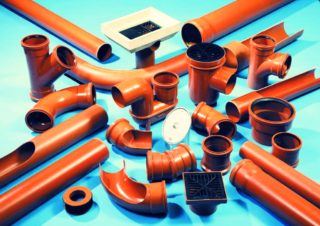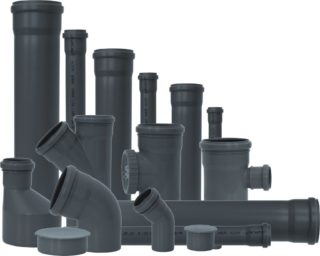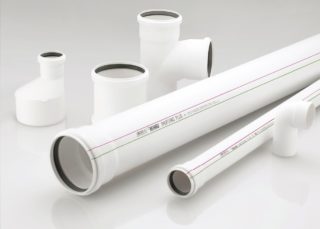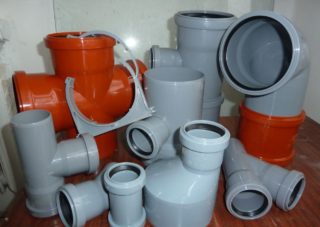The obvious advantages of polymers lead to an ever-growing proportion of plastic pipes in sewer systems. What kind of materials are used in their production and how to make the right choice?
Where are plastic sewer pipes used?
Cast iron, steel, asbestos and concrete, which provided the needs of communication systems in the last century, were replaced by plastic of various modifications. Polymer pipes are successfully used in external and internal drainage systems, sewers.
The peculiarities of the plastic composition determine the operating conditions and the scope of the pipes. It can be both gravity systems, as well as pressure ones, with pressures up to 10 atm.
Low hydraulic resistance, durability, resistance to chemical attack, simple installation and transportation make pipes made of all types of plastic very attractive for developers.
Types of pipes and differences in application
- polyvinyl chloride (PVC);
- polypropylene (PPL);
- polyethylene (LDPE or HDPE).
In the construction of modern housing stock, PVC pipes with a solid inner wall are most widely used. They have a monolithic (single-layer) or three-layer construction. According to the index of ring stiffness SN, five categories are distinguished: 2, 4, 8, 16 or 32 kN / m2. Accordingly, the thinner the wall, the lower the stiffness indicator, which means that the pipe can withstand a lower load.
To facilitate control of the hardness, the products are available in different colors. SN2 and SN4 are gray and are used only indoors, in boxes, trays and grooves. Wall thickness 2.7 mm.
SN8 orange pipes (three-layer) have a wall of 3.7 mm and are intended for use outside buildings, can be laid in trenches, and can withstand significant mechanical stress.
White color indicates that the pipe wall is 3.4 mm thick. This is a three-layer construction with increased noise absorption.
Polypropylene has greater elasticity, is stably resistant to temperatures up to 70 ° C, and with short-term exposure (no more than 60 seconds) it can withstand 90 ° C.
During transportation and installation in low temperature conditions, PPL pipes better withstand shock loads.
Low-pressure polyethylene (HDPE) is highly durable and is used in pressure drainage systems. Able to bear pressure up to 10 atm. But there is a limitation on the operating temperature (up to + 60 ° C). With prolonged exposure to hot water, it deforms.
It is an elastic material with a high yield point. It reacts to longitudinal tensile load by elongation rather than destruction.
Spiral pipes with diameters up to 1600 mm are made of polymerized ethylene. At the same time, the inner surface is smooth so as not to increase the hydraulic resistance. Such a two-layer structure significantly expands the throughput of the sewage system.
Varieties of forms and compounds
The main elements of engineering structures for drainage:
- pipe with a diameter from 32 mm to 200 mm;
- tee;
- knee with different angles of rotation;
- coupling sleeve;
- revision clutch;
- transition to another diameter;
- stub.
All engineering problems arising during the operation of the system are solved by installing the appropriate components.
For PVC and PPL products, detachable connections are characteristic, which ensures the reusability of structural elements. The socket is equipped with a special sealing rubber, which, if properly installed, guarantees a tight connection throughout the entire service life (guaranteed 50 years).
Polyethylene pipes are connected in one of three ways:
- with rubber seal;
- glue;
- welded.
With the welded method, the material heats up and, as a result of the diffusion of areas exposed to thermal effects, a strong connection is created. This is an all-in-one way.
Standard sizes
Washing machine, dishwasher are connected to the system through a diameter of 32 mm. Washbasin, sink, bathroom, shower cubicle - 50 mm. Toilet bowl - 110 mm. With this arrangement, the cross-section of the pipe fully copes with the imposed load.
Trunk channels can be assembled on the basis of pipes of a larger cross-section, depending on the design operating conditions.
Features of installation and operation
For polyethylene products, it is important to remember the coefficient of thermal expansion. During installation, expansion gaps should be left so that expansion does not lead to deformation of the pipe.
When organizing an external sewage system, it is necessary to exclude freezing of the structure in the winter.
If a polyethylene pipe loyally reacts to freezing and restores its shape after defrosting, then PVC can get cracking and depressurization. It is important to avoid negative temperatures in the system.
When choosing a material for utilities, you should take into account the design operating conditions. In standard living conditions, PVC pipes, the most affordable at a cost, cope with drainage. If there are no special conditions, this is the perfect solution.












